
BELOW LISTED SIX MEDICINAL HERBAL EXTRACTS ARE PRESCRIBED FOR CANCER PATIENTS TO ENABLE A COMPLETE & SUCCESSFUL "REMISSION" :
1) Fagonia cretica (Leaf : Flower : Stem)

Fagonia Cretica – Fagonia cretica, also known as Dhamasa or Virgin’s Mantle, has been the subject of scientific inquiry due to its potential therapeutic properties, particularly in the realm of cancer. The plant’s efficacy in cancer treatment may be attributed to a variety of properties and constituents that set it apart.
Here’s a closer look at what makes Fagonia cretica such a wonderful medicinal plant and potentially valuable in addressing cancer:
Phytochemical Diversity: Fagonia cretica is rich in phytochemicals, including alkaloids, flavonoids, saponins, tannins, and terpenoids. These bioactive compounds have shown diverse biological activities, contributing to the plant’s potential anticancer effects.
Flavonoids with Antioxidant Potential: Flavonoids found in Fagonia cretica exhibit potent antioxidant properties. Antioxidants play a crucial role in neutralizing free radicals, which are reactive molecules that can damage DNA and contribute to cancer development. By reducing oxidative stress, Fagonia cretica may help mitigate one of the factors linked to cancer initiation.
Polyphenolic Compounds: The presence of polyphenolic compounds in Fagonia cretica contributes to its antioxidant and anti-inflammatory properties. Polyphenols have been associated with inhibiting the growth of cancer cells and modulating signaling pathways involved in cancer development.
Apoptosis-Inducing Agents: Fagonia cretica has shown promise in inducing apoptosis, the programmed cell death essential for maintaining cellular balance. The plant’s bioactive compounds trigger apoptosis specifically in cancer cells, helping to eliminate them while sparing healthy cells.
Immunomodulatory Effects: Immunomodulation, or the ability to regulate the immune system, is a crucial aspect of cancer therapy. Fagonia cretica constituents have demonstrated immunomodulatory effects, potentially enhancing the body’s ability to recognize and eliminate cancer cells.
Anti-Inflammatory Actions: Chronic inflammation is closely linked to cancer progression. Fagonia cretica exhibits anti-inflammatory effects, which help create an environment less conducive to the growth and spread of cancer cells.
Cell Cycle Regulation: Compounds within Fagonia cretica interfere with the cell cycle of cancer cells. By disrupting the uncontrolled division of cancerous cells, the plant’s constituents may contribute to slowing down or halting tumor growth.
Traditional Use and Ethnobotanical Knowledge: Fagonia cretica has a history of traditional use in various cultures for its medicinal properties. This traditional knowledge often serves as a starting point for scientific investigation, guiding researchers toward potential therapeutic benefits.
2) Holy Basil (Leaf)
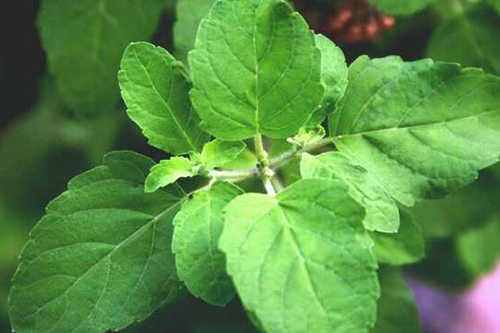
Holy Basil, scientifically known as Ocimum sanctum or Tulsi, has garnered attention for its potential health benefits, including its role in cancer prevention and treatment. Several properties and constituents contribute to the potential usefulness of Holy Basil in cancer management.
Here’s a detailed exploration of what makes Holy Basil such a promising and useful medicinal plant in the fight against cancer:
Antioxidant Richness: Holy Basil is abundant in antioxidants, such as flavonoids and polyphenols. These compounds help neutralize free radicals, unstable molecules that can damage cells and contribute to cancer development. By reducing oxidative stress, Holy Basil supports cellular health and help prevent cancer initiation.
Anti-Inflammatory Effects: Chronic inflammation is a key factor in the development and progression of cancer. Holy Basil has demonstrated anti-inflammatory properties, potentially inhibiting inflammatory pathways and creating an environment less conducive to cancer growth.
Radioprotective Properties: Holy Basil has shown radioprotective effects, meaning it help protect normal tissues from the harmful effects of radiation therapy commonly used in cancer treatment. This property can be particularly valuable in minimizing collateral damage during cancer therapy.
Immunomodulation: Holy Basil is known for its immunomodulatory effects, influencing the activity of the immune system. A robust immune response is essential in identifying and eliminating cancer cells. Holy Basil’s ability to modulate immune function enhance the body’s natural defenses against cancer.
Anti-Angiogenic Activity: Angiogenesis, the formation of new blood vessels, is a critical process for tumor growth. Holy Basil has exhibited anti-angiogenic properties, potentially inhibiting the development of blood vessels that supply nutrients to cancerous cells and restricting their ability to thrive.
Apoptosis Induction: Holy Basil contains compounds that have been studied for their ability to induce apoptosis, or programmed cell death, in cancer cells. This process is essential for eliminating abnormal cells and preventing their uncontrolled growth.
DNA Repair Enhancement: Some constituents of Holy Basil have been linked to enhanced DNA repair mechanisms. Efficient DNA repair is crucial in preventing the accumulation of genetic mutations that could lead to cancer development.
Adaptogenic Nature: Holy Basil is classified as an adaptogen, meaning it helps the body adapt to stressors, including those that contribute to cancer progression. By promoting overall resilience, Holy Basil support the body in maintaining balance and preventing the conditions favorable for cancer growth.
Traditional Wisdom: Holy Basil has a rich history of traditional use in various medicinal practices, particularly in Ayurveda. The accumulated wisdom of generations often serves as an initial indicator of a plant’s potential therapeutic benefits.
3) Wheatgrass (Leaf) and Tinospora cordifolia (Stem)
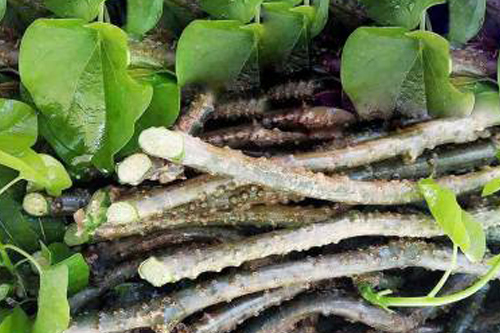
Wheatgrass (Leaf) and Tinospora cordifolia (Stem) : Wheatgrass and Giloy, two distinct botanical entities, have individually demonstrated promising properties that could potentially contribute to cancer prevention and treatment. While scientific research is ongoing, certain properties and constituents of these plants have attracted attention for their potential benefits in the context of cancer.
Here’s a detailed exploration of what makes Wheatgrass and Giloy potentially very useful in addressing cancer:
Wheatgrass:
Rich in Antioxidants: Wheatgrass is a powerhouse of antioxidants, including vitamins A, C, and E, as well as chlorophyll. These antioxidants help combat free radicals, reducing oxidative stress and potentially preventing DNA damage that can lead to the initiation and progression of cancer.
Detoxification Support: Wheatgrass is believed to aid in detoxification by supporting liver function. A healthy liver is crucial for processing toxins and preventing the buildup of harmful substances, which contribute to cancer development.
Anti-Inflammatory Properties: Chronic inflammation is associated with various types of cancer. Wheatgrass has demonstrated anti-inflammatory effects, potentially helping to create an environment less favorable for the growth and spread of cancer cells.
Immune System Enhancement: Wheatgrass is suggested to boost the immune system, improving the body’s ability to recognize and eliminate abnormal cells, including cancer cells. A robust immune response is essential for cancer prevention and treatment.
Alkalizing Potential: Wheatgrass is considered alkaline, and maintaining a slightly alkaline environment in the body is believed to be unfavorable for the growth of cancer cells. This alkalizing effect contribute to creating conditions less conducive to cancer development.
Potential for Apoptosis Induction: Studies indicate that Wheatgrass extracts induce apoptosis, or programmed cell death, in cancer cells. This property is crucial for preventing the uncontrolled growth of abnormal cells.
Giloy (Tinospora cordifolia):
Immunomodulatory Effects: Giloy is renowned for its immunomodulatory properties, meaning it can modulate the activity of the immune system. A strong immune response is essential in recognizing and eliminating cancer cells, making Giloy a potential ally in cancer prevention.
Anti-Inflammatory and Antioxidant Activity: Giloy exhibits both anti-inflammatory and antioxidant effects. By reducing inflammation and neutralizing free radicals, it contribute to creating an environment less conducive to cancer growth.
Anti-Cancer Alkaloids: Some alkaloids present in Giloy, such as berberine and palmatine, have been studied for their potential anti-cancer effects. These compounds interfere with cancer cell proliferation and induce apoptosis.
Enhanced DNA Repair: Giloy has been investigated for its role in enhancing DNA repair mechanisms. Efficient DNA repair is crucial for preventing the accumulation of genetic mutations that could lead to the development of cancer.
Adaptogenic Nature: Giloy is classified as an adaptogen, helping the body adapt to stressors. Cancer itself and the treatments can be physically and emotionally stressful, and the adaptogenic properties of Giloy contribute to overall well-being during cancer management.
4) Curcumin, a polyphenol extracted from Curcuma longa
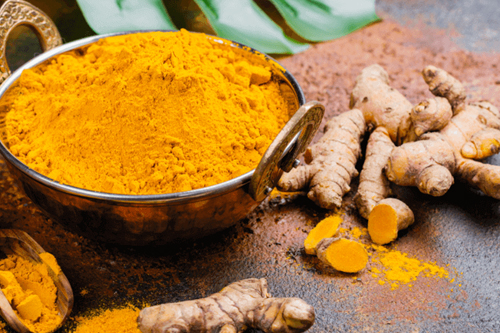
Curcumin, the active compound found in turmeric (Curcuma longa), has gained considerable attention for its potential therapeutic properties, particularly in the context of cancer.
Extensive research has highlighted several properties and constituents that make curcumin a promising and very useful medicinal herb for cancer prevention and treatment:
Powerful Antioxidant Activity: Curcumin is a potent antioxidant that scavenges free radicals in the body. By neutralizing these reactive molecules, curcumin helps protect cells from oxidative damage, which is implicated in the initiation and progression of cancer.
Anti-Inflammatory Effects: Chronic inflammation is a common factor in cancer development. Curcumin possesses strong anti-inflammatory properties, inhibiting key inflammatory pathways. This dual action of antioxidant and anti-inflammatory effects create an environment less conducive to cancer growth.
Apoptosis Induction: One of the hallmark features of cancer cells is their ability to evade programmed cell death, or apoptosis. Curcumin has demonstrated the potential to induce apoptosis specifically in cancer cells, helping to eliminate them in a controlled manner and impeding their uncontrolled proliferation.
Inhibition of Cancer Cell Proliferation: Curcumin has been shown to interfere with the growth and multiplication of cancer cells. It modulates various signaling pathways involved in cell cycle regulation, slowing down the division of cancerous cells and potentially inhibiting tumor growth.
Anti-Angiogenic Properties: Angiogenesis, the formation of new blood vessels, is crucial for tumor growth and metastasis. Curcumin has anti-angiogenic effects, meaning it inhibit the development of blood vessels that supply nutrients to cancer cells, restricting their ability to thrive.
Modulation of Cellular Signaling Pathways: Curcumin influences multiple signaling pathways associated with cancer development, including the nuclear factor-kappa B (NF-κB) pathway. By modulating these pathways, curcumin regulate gene expression and interfere with processes that contribute to cancer progression.
Enhanced Radiosensitivity: Studies suggest that curcumin enhance the sensitivity of cancer cells to radiation therapy. This property can potentially improve the effectiveness of radiation treatment while minimizing damage to surrounding healthy tissues.
Chemosensitization: Curcumin has been investigated for its ability to enhance the efficacy of chemotherapy drugs. By making cancer cells more sensitive to conventional treatments, curcumin help improve the overall effectiveness of chemotherapy.
Protection of Healthy Cells: While curcumin demonstrates anticancer effects, it has been observed to protect normal, healthy cells from the side effects of cancer treatments. This dual role is crucial in maintaining overall well-being during cancer therapy.
5) Lochenra Rosea (Leaf)
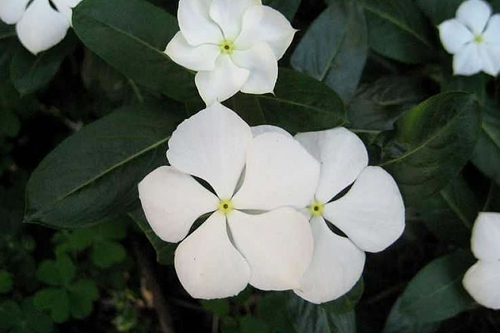
Lochenra Rosea (Leaf) – The plant is a rich source of various alkaloids, and the most well-known and researched constituents are vincristine and vinblastine. These compounds, among others, contribute to Lochnera rosea’s potential usefulness in cancer.
Here are some properties and constituents that make Lochnera rosea a very useful and promising medicinal plant in the fight against cancer:
Vinca Alkaloids – Vincristine and Vinblastine: Lochnera rosea is renowned for its alkaloid content, particularly vincristine and vinblastine. These alkaloids have demonstrated powerful anticancer properties by interfering with the microtubule structures involved in cell division. Vincristine and vinblastine are used in the treatment of various cancers, including leukemia and lymphoma, due to their ability to inhibit the proliferation of cancer cells.
Cytotoxic and Apoptotic Effects: Vincristine and vinblastine derived from Lochnera rosea have shown cytotoxic effects, inducing cell death in cancer cells. They also promote apoptosis, the programmed cell death process that helps regulate cell growth and prevent the survival of abnormal cells.
Anti-Angiogenic Properties: Lochnera rosea extracts have demonstrated anti-angiogenic effects, meaning they inhibit the formation of new blood vessels that supply nutrients to tumors. This property can hinder the growth and spread of cancer by cutting off the blood supply to the malignant cells.
Immunomodulatory Effects: Some research suggests that Lochnera rosea have immunomodulatory properties, influencing the activity of the immune system. A strengthened immune response is crucial for identifying and eliminating cancer cells.
DNA Repair Inhibition: Certain constituents in Lochnera rosea have been studied for their potential to inhibit DNA repair mechanisms in cancer cells. Impairing DNA repair can contribute to the prevention of cancer cell survival and proliferation.
Free Radical Scavenging: Lochnera rosea contains antioxidants that help neutralize free radicals in the body. Free radicals can contribute to DNA damage and cancer development, and the antioxidant properties of Lochnera rosea play a role in preventing this process.
Combination Therapy Enhancer: Vincristine and vinblastine derived from Lochnera rosea are often used as part of combination chemotherapy regimens. Their inclusion enhances the overall efficacy of cancer treatment, offering a synergistic effect when combined with other therapeutic agents.
Clinical Success: Vincristine and vinblastine, isolated from Lochnera rosea, have been successfully used in the treatment of various cancers for several decades. Their established clinical use underscores the plant’s potential utility in cancer therapy.
6) Podophyllum hexandrum (Fruit)
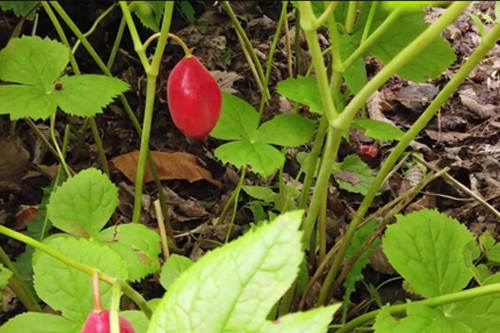
Podophyllum hexandrum – Podophyllum hexandrum, commonly known as Indian Podophyllum or Himalayan Mayapple, is a plant that has drawn attention for its potential medicinal properties, particularly in the field of cancer. The plant contains a group of bioactive compounds known as lignans, with podophyllotoxin being one of the most well-studied constituents.
Here are some properties and constituents that make Podophyllum hexandrum very useful and a must one to be included in the fight against cancer:
Podophyllotoxin – Anticancer Agent: Podophyllum hexandrum is renowned for its lignan content, particularly podophyllotoxin. This compound has shown potent anticancer properties by interfering with microtubule dynamics during cell division. Podophyllotoxin and its derivatives have been used in the development of chemotherapeutic drugs, such as etoposide and teniposide, which are employed in the treatment of various cancers.
Cytotoxic and Antiproliferative Effects: Podophyllotoxin exhibits cytotoxic effects on cancer cells, hindering their ability to proliferate. By interfering with the assembly of microtubules, it disrupts the normal process of cell division, leading to cell cycle arrest and, in some cases, apoptosis (programmed cell death).
Apoptosis Induction: Podophyllotoxin derived from Podophyllum hexandrum has demonstrated the ability to induce apoptosis in cancer cells. This is a crucial mechanism in cancer treatment, ensuring the targeted elimination of abnormal cells and preventing uncontrolled growth.
DNA Damage and Topoisomerase Inhibition: Podophyllotoxin interferes with topoisomerases, enzymes that play a role in DNA replication and repair. By inhibiting topoisomerases, Podophyllum hexandrum disrupts DNA synthesis and induces DNA damage in cancer cells, contributing to their demise.
Anti-Angiogenic Properties: Some studies suggest that Podophyllum hexandrum extracts possess anti-angiogenic effects, meaning they can inhibit the formation of new blood vessels that supply nutrients to tumors. This property can impede the growth and metastasis of cancer cells.
Immunomodulatory Effects: While research is ongoing, there is evidence to suggest that Podophyllum hexandrum have immunomodulatory properties. Modulating the immune system can enhance the body’s ability to recognize and eliminate cancer cells.
Potential for Combination Therapy: Podophyllotoxin and its derivatives from Podophyllum hexandrum are often used in combination with other anticancer agents. This approach can enhance the overall efficacy of cancer treatment and reduce the risk of drug resistance.
Clinical Applications: Podophyllotoxin-based drugs have been clinically used in cancer therapy for several decades. Their successful application underscores the plant’s potential utility in the treatment of various malignancies.

